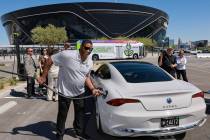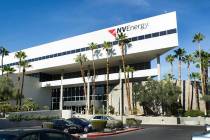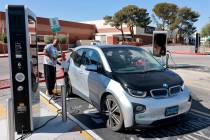Feather-light foot increases hybrid mileage
A reader, L.L., writes:
"When (my husband) Robert was talking to a guy who worked at the Toyota dealership, after we bought a Prius, the employee said that a lot of people complain they aren't getting the estimated mileage out of the vehicle. He said this is because you can't drive a hybrid like a regular gas car. I've been looking online since we got the Prius to find out how to get the maximum mileage out of the car ... People online boast that they can get 70 mpg out of the current Prius, which is well above the estimated 45/48 it gets on the sticker."
The Toyota rep is right: To get the most out of a hybrid, you have to drive it differently. Many of these driving techniques have been around since the dawn of the automobile age and are just as valuable for enhancing mileage and range performance for gasoline-only cars.
A light foot is better than a lead foot when applying power to the wheels of a hybrid. Electric motors use the most electricity when first accelerating from a standing stop. However, because of its inherent low-end torque, only a modest amount of throttle pedal needs to be applied to get the vehicle rolling; pushing the pedal to the floor wastes more battery power than necessary. Once the vehicle is in motion, it requires even less battery pack current to keep it spinning. Using a "feather-light" foot by lightly tap and releasing the the accelerator will create gentle pulses of power that keep the motor spinning and the vehicle gliding forward. It also helps if the driver can look ahead at upcoming traffic lights to try to time their changes so that the electric motor can continue spinning at its normal cruising speed to minimize battery current flow.
One other advantage of an electric motor is that it can also create electricity while the wheels are spinning freely, such as when the vehicle is coasting downhill or coming to a stop without using battery power. Today's computer-controlled vehicle electronics can feed this harvested energy back to the battery pack to recharge it. The conversion of the kinetic energy to electricity also slows the motor down internally, diminishing the need for the mechanical braking system. The combination of these effects is called regenerative braking or "regen" for short.
Releasing the accelerator pedal earlier while gliding to a stop also minimizes the use of the brake pedal and has the additional benefit of prolonging the life of the braking system.
The Toyota Synergy hybrid gasoline/electric drive train system has revolutionized the automotive world. Like a video game console, the dashboard touch-panel display screen allows the driver to monitor gas usage versus battery electric usage in real time. The information is presented graphically or numerically on two separate menus that drivers can access with a single touch to the screen. This continuous stream of data tells the driver how many miles per gallon of gasoline are being achieved based on that person's driving technique at each point along the route. The display provides instant feedback in the same way a video game challenges a player to continuously improve performance.
The recent popularity of hybrid cars has spawned a new motor sport called "hypermiling," a term originated by Wayne Gerdes of the Web site CleanMPG.com. Hypermilers try to optimize their driving skills to see just how far they can go on a single tank of gas and the numbers are impressive. Distance measurements exceeding 20 miles per gallon above the standard EPA-certified mpg vehicle ratings are possible using hypermiling, in both hybrid and gasoline-only vehicles. In 2006, Gerdes and his team set a world record with a 2001 Honda Insight hybrid by traveling 2,254 miles on a single 13.7-gallon tank of gas, for an average of 164.53 miles per gallon.
In April 2009, Ford Motor Co. demonstrated the potential range of its new 2010 Fusion Hybrid by sponsoring a 1,000-mile challenge. Gerdes and NASCAR driver Carl Edwards led a Ford team on a cross-country road trip that included city driving. The team covered 1,445.7 miles on open roads using just one tank of gas, averaging 81.5 miles per gallon.
Of the Detroit Three, Ford Motor Co. has made the strongest efforts to compete against Toyota's Synergy hybrid technology. The company originally licensed an early version of Toyota Synergy hybrid drive system for use in its 2005 Ford Escape Hybrid SUV. Ford design engineers then began research on hybrid vehicle platforms as well as hydrogen fuel cell electric vehicle platforms.
Lessons learned from this research were incorporated into the 2010 Ford Fusion Hybrid and 2010 Mercury Milan Hybrid and, since then, Ford engineers have made incremental improvements over the Toyota Prius Synergy technology. These include a smaller, lighter nickel-metal hydride battery pack that allows the Fusion Hybrid to accelerate up to 47 mph before the gasoline engine is required for assistance, almost twice the top speed threshold of the Toyota Prius. This allows for more flexibility of electric-only operation in traffic conditions, especially on roads where speed limits are 35 mph or 45 mph.
On the instrument panel, Ford's SmartGauge with EcoGuide features two display screens on either side of the analog speedometer that are used to coach drivers about how to optimize the performance of their hybrid. These display screens can show instant fuel economy, fuel economy history, odometer, engine coolant temperature, gear selection status, trip fuel economy, time-elapsed fuel economy and miles to empty. The Ford Fusion is equipped with a 17-gallon gas tank that can potentially deliver a hybrid range of 700 miles. EPA-certified gas consumption ratings are 41 mpg in the city and 36 mpg on the highway.
For more information on getting the best fuel performance from any vehicle, visit Gerdes' Web site, www.CleanMPG.com.
Stan Hanel has worked in the electronics industry for more than 30 years and is a long-time member of the Electric Auto Association and the Las Vegas Electric Vehicle Association. Hanel writes and edits for EAA's "Current Events" and LVEVA's "Watts Happening" newletters. Contact him at stanhanel@aol.com.

















